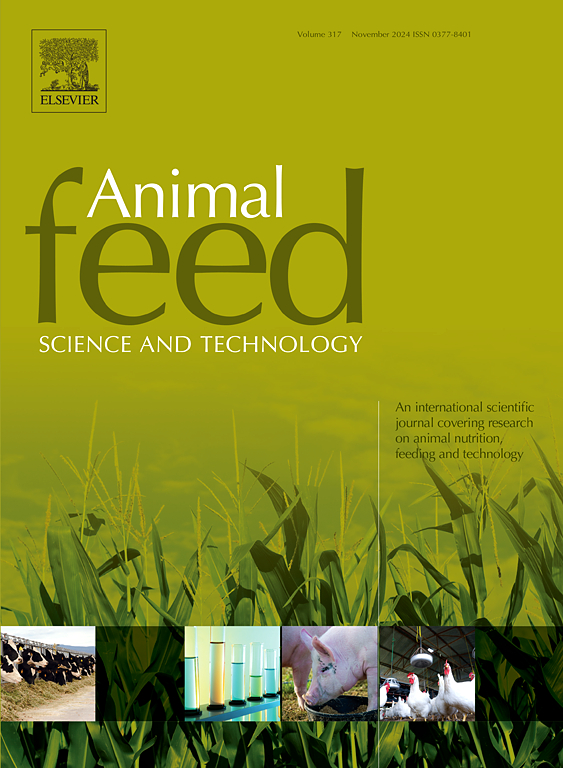大蒜素对黑山羊生长性能、屠宰性能、抗氧化、免疫参数和经济效益的影响
IF 2.5
2区 农林科学
Q1 AGRICULTURE, DAIRY & ANIMAL SCIENCE
引用次数: 0
摘要
本试验旨在揭示大蒜素对贵州黑山羊生长性能、屠宰性能、血清生化指标及经济效益的影响。选取平均初始体重为18.28 ± 0.41 kg的贵州黑山羊公山羊32只,随机分为4组,每组8个重复(n = 8)。对照组饲喂不添加大蒜素的基础饲粮,其余3个处理组分别在基础饲粮中添加低量(0.5 g/头/天)、中量(0.75 g/头/天)和高量(1 g/头/天)的大蒜素。结果表明:与对照组相比,中大蒜素组显著提高了贵州黑山羊的干物质采食量(DMI)、末重(FBW)、热胴体重(HCW)、屠宰率(DP)、围肋组织厚度(GR值)和肝、脾、肾重量(P <; 0.05)。各大蒜素添加组的平均日增重(ADG)均高于对照组(P = 0.006),饲料系数低于对照组(P = 0.020)。中等大蒜素组血清葡萄糖、尿素氮(BUN)、甘油三酯(TG)、低密度脂蛋白胆固醇(LDL-C)、丙二醛(MDA)、氧化谷胱甘肽(GSSG)、天冬氨酸转氨酶(ALT)水平均低于对照组(P <; 0.05)。相反,高密度脂蛋白胆固醇(HDL-C)、过氧化氢酶(CAT)、谷胱甘肽过氧化物酶(GSH-Px)、超氧化物歧化酶(SOD)、总抗氧化能力(T-AOC)和白细胞介素-10 (IL-10)水平高于对照组(P <; 0.05)。值得注意的是,与对照组相比,所有大蒜素添加组的免疫球蛋白A (IgA)、免疫球蛋白M (IgM)和免疫球蛋白G (IgG)水平均有所提高(P <; 0.05),而肿瘤坏死因子-α (TNF-α)和丙氨酸转氨酶(AST)水平均有所降低(P <; 0.001)。最后,与对照组相比,添加大蒜素降低了饲料增重成本(FWGC) (P = 0.041)。此外,中等大蒜素组在提高体重增加效益(WGB)方面表现出优越的效果(P = 0.030)。由此可见,添加大蒜素提高了贵州黑山羊的采食量、生长性能、屠宰性能以及抗氧化、抗炎、免疫调节、经济效益和降糖效果。其中,中等大蒜素组的改善效果最为显著。本文章由计算机程序翻译,如有差异,请以英文原文为准。
Effects of allicin on growth performance, slaughter performance, antioxidant, immune parameters and economic benefits of black goats
This study aimed to reveal the effects of allicin on growth performance, slaughter performance, serum biochemical parameters, and economic benefits of Guizhou black goats. 32 Guizhou black male goats with a mean initial body weight of 18.28 ± 0.41 kg were selected and randomly divided into 4 groups with 8 experimental replicates in each group (n = 8). The control group was fed a basal diet without allicin, while the other three treatment groups were supplemented with low (0.5 g/head/day), medium (0.75 g/head/day), and high (1 g/head/day) amounts of allicin in the basal diet. The findings indicated that the medium allicin group improved (P < 0.05) dry matter intake (DMI), final body weight (FBW), hot carcass weight (HCW), dressing percentage (DP), girth rib tissue thickness (GR value), and the weight of liver, spleen, and kidney in Guizhou black goats compared to the control group. Moreover, the average daily gain (ADG) in all allicin-supplemented groups was higher (P = 0.006) than that in the control group, whereas the feed conversion ratio was lower (P = 0.020). In the medium allicin group, serum levels of glucose, blood urea nitrogen (BUN), triglycerides (TG), low-density lipoprotein cholesterol (LDL-C), malondialdehyde (MDA), oxidized glutathione (GSSG), and aspartate aminotransferase (ALT) were lower (P < 0.05) than those in the control group. Conversely, levels of high-density lipoprotein cholesterol (HDL-C), catalase (CAT), glutathione peroxidase (GSH-Px), superoxide dismutase (SOD), total antioxidant capacity (T-AOC), and interleukin-10 (IL-10) were higher (P < 0.05) than those in the control group. Notably, in all allicin-supplemented groups, immunoglobulin A (IgA), immunoglobulin M (IgM), and immunoglobulin G (IgG) levels were improved (P < 0.05) compared to the control group, whereas tumor necrosis factor-α (TNF-α) and alanine aminotransferase (AST) levels were reduced (P < 0.001). Finally, compared to the control group, allicin supplementation reduced (P = 0.041) feed weight gain cost (FWGC). Additionally, the medium allicin group demonstrated a superior effect in enhancing weight gain benefit (WGB) (P = 0.030). In conclusion, allicin supplementation improved feed intake, growth performance, slaughter performance, antioxidant, anti-inflammatory, immunomodulatory, economic benefits, and hypoglycemic effects of Guizhou black goats. Among the groups, the medium allicin group exhibited the most significant improvements.
求助全文
通过发布文献求助,成功后即可免费获取论文全文。
去求助
来源期刊

Animal Feed Science and Technology
农林科学-奶制品与动物科学
CiteScore
6.00
自引率
6.20%
发文量
266
审稿时长
3 months
期刊介绍:
Animal Feed Science and Technology is a unique journal publishing scientific papers of international interest focusing on animal feeds and their feeding.
Papers describing research on feed for ruminants and non-ruminants, including poultry, horses, companion animals and aquatic animals, are welcome.
The journal covers the following areas:
Nutritive value of feeds (e.g., assessment, improvement)
Methods of conserving and processing feeds that affect their nutritional value
Agronomic and climatic factors influencing the nutritive value of feeds
Utilization of feeds and the improvement of such
Metabolic, production, reproduction and health responses, as well as potential environmental impacts, of diet inputs and feed technologies (e.g., feeds, feed additives, feed components, mycotoxins)
Mathematical models relating directly to animal-feed interactions
Analytical and experimental methods for feed evaluation
Environmental impacts of feed technologies in animal production.
 求助内容:
求助内容: 应助结果提醒方式:
应助结果提醒方式:


